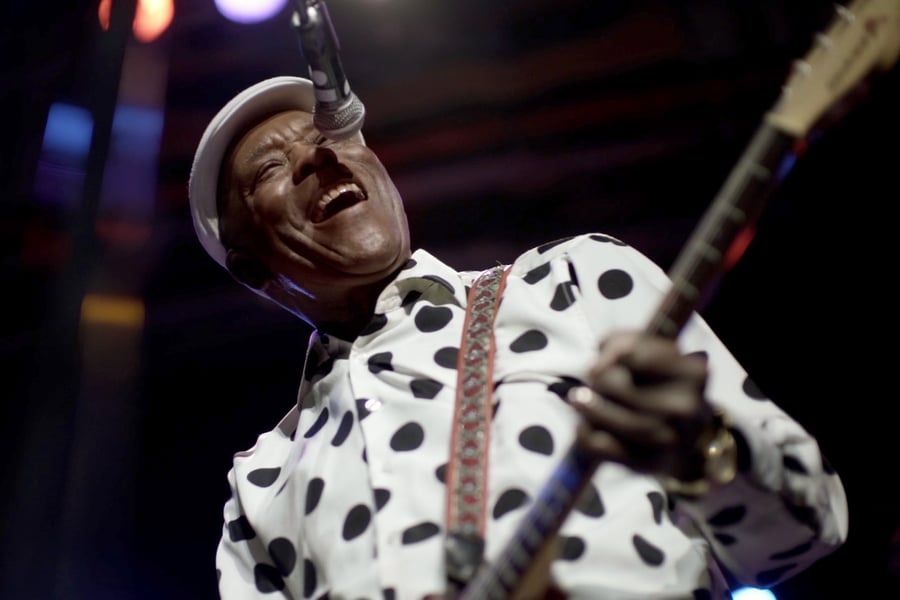That moldy-peaches cliché “they don’t make ‘em like they used to” has rarely applied to anyone as much as Buddy Guy. As his former protégé Joe Bonamassa says in The Torch, a new doc about Guy, the now-85-year-old blues guitarist and singer is “the last man standing.” He really is: Guy is one of the few still-breathing blues veterans who can boast that he played behind Howlin’ Wolf and Muddy Waters, and wowed Jeff Beck, Eric Clapton and the Rolling Stones when they were all twentysomething Brits learning the genre.
And this last guy standing barely stands in place. An extremely physical performer who yielded his guitar (as Carlos Santana once put it) like a blowtorch, Guy is seen continuing his tradition of venturing out into the audience while still playing. In The Torch, he even leaves one venue, hops in a cab, and takes a quick ride around the block before returning to the club, bending the strings on his unamplified instrument the entire time.
Guy’s back story and career — the way he struggled to be heard and acknowledged in his own genre for many years — were chronicled in last year’s eloquent doc Buddy Guy: The Blues Chase the Blues Away. The Torch, directed by Jim Farrell, rehashes the basics of the musician’s bio, throwing in a few new tales along the way. With his typical relish for savoring a story, Guy recalls riding around Chicago with Waters, both of them eating pastrami sandwiches, or meeting Hooker for the first time (and not realizing it was him to begin with). But the film largely focuses on Guy’s current life, so we meet his band and his supportive producer Tom Hambridge, and we see the way that the guitarist, in his eighties, can still summon up piercing notes and admonish a crowd for not responding as enthusiastically as he wants.
The title carries dual meanings. It points out the way Guy has become a torch-bearer himself by peppering his shows with covers of Waters and Hooker classics; he doesn’t want anyone to forget the basic repertoire. But the metaphor also applies to the way Guy has become a mentor to a new generation of blues musicians, and the film focuses on one of them, Quinn Sullivan. Now 22, Sullivan started playing guitar when he was barely in kindergarten. At the age of seven, the Massachusetts kid was invited onstage to play with Guy. Few took his cameo that night seriously, but it turned out the kid more than knew his way around blues guitar (thanks to his Allmans-loving parents). Guy, who calls Sullivan “the next superstar — the person who can keep this thing going,” soon takes the younger player under his wing. A good chunk of The Torch is devoted to footage of Sullivan recording, playing with and learning from Guy; he comes across as a humble kid who can’t quite believe he’s found himself being taught by a master. “He rejuvenates Buddy,” says Derek Trucks. “They keep each other going.”
A few wrenches are thrown in along the way. Precisely how much Sullivan will keep the blues alive is one of them, and for all his devotion to the genre, he doesn’t seem limited to the form. When we see Sullivan fronting a band or singing himself, both his voice and guitar feel more rock, even Southern-dipped (one of his solos recalls Dickey Betts). Here and there, Santana pops up to offer Sullivan tips on how to succeed in the business, most of which encourage Sullivan to bust out of any preconceived mold. “You just need one song that goes viral,” he says, and then, later, “Expand your portfolio and your Rolodex.” (The comments say as much about Santana and his marketing savvy as they do about Sullivan.) At the end of The Torch, Sullivan is seen singing and playing one of his own tunes, an acoustic ballad that feels more Americana or country than anything blues-related.
And not to put too fine a point on it, but Sullivan — who transforms from a cherubic, sharp-dressed little kid to a lanky teen — is white. White blues players have long contributed to the genre, and have paid homage to the men and women who invented it. But The Torch, which never acknowledges the racial issue here, arrives at a somewhat awkward time. A slew of young, Black blues musicians — including Christone “Kingfish” Ingram, also seen here and clearly a Guy devotee — are making the case that the music has been overtaken by too many non-Black performers and needs to be reclaimed. Watching Sullivan trade licks with Guy is a welcome reminder that music can transcend race and bring people together. It will be fascinating to see where Sullivan winds up. But the movie may unsettle purists who feel that torch needs to be passed around to a more diverse crew of musicians.
From Rolling Stone US
Love Music?
Get your daily dose of everything happening in Australian/New Zealand music and globally.



































